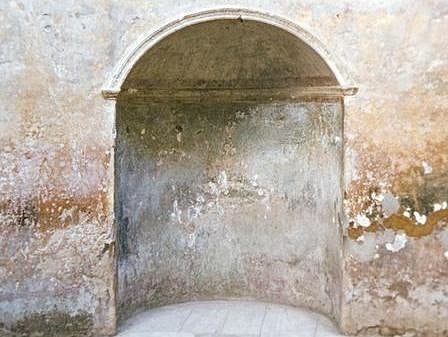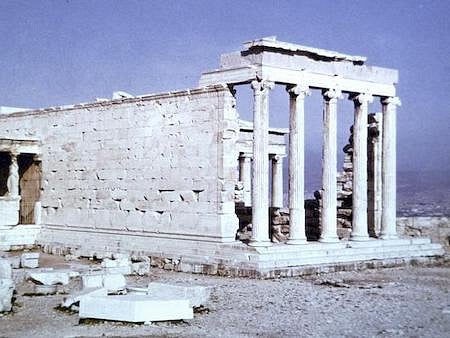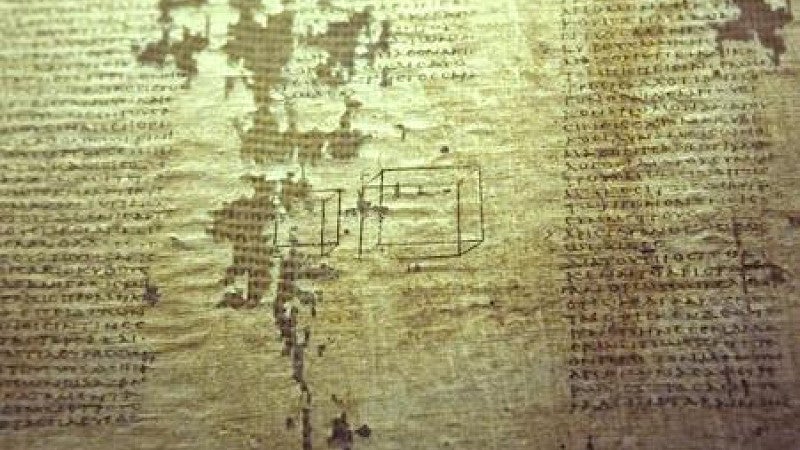The Department of Classics offers a bachelor of arts degree. Students may choose to focus on Latin language and literature, Greek language and literature, or a combination of Greek and Latin. Students may also study the literature and culture of the ancient civilizations through courses that use secondary sources and translated texts or they may focus on Classical Archaeology and material culture.
Courses used to satisfy major requirements must be taken for letter grades and passed with a mid-C or better. At least four upper-division courses (normally 16 credits) must be taken at the University of Oregon.
Four-Year Degree Plans
The degree plan shown is only a sample of how students may complete their degrees in four years. There are alternative ways. Students should consult their advisor to determine the best path for them.
Classical Civilization Concentration (48 credits)

- Three courses in upper-division Greek or Latin (GRK 301, 302, 303 or LAT 301, 302, 303) (12 credits)
- One course in classical archaeology (CLAS 188, 399, 407) (4 credits)
- Ancient Greece (HIST 412) and Ancient Rome (HIST 414) (8 credits)
- Two courses in ancient art, selected from (ARH 322, 323) (8 credits)
- Two elective courses (CLAS 201, 202, 301, 302, 303, HUM 101) (8 credits)
- Two elective courses chosen in consultation with a classics department advisor from approved list (see below) (8 credits)
Students should complete the introductory language courses with grades of mid-C or better or demonstrate proficiency at the introductory level. Students must demonstrate proficiency in Greek or Latin by completing LAT 301, 302, 303 or GRK 301, 302, 303 or their equivalents with grades of mid-C or better. Students whose Greek or Latin was taken entirely in high school must take one year of second- or third-year Greek or Latin (301, 302, 303, or 411) at the University of Oregon in works not read in their high school courses. All language courses at the second- or third-year level may count toward the 20 credits of electives.
Why study Classical Civilization Concentration? What’s required to earn a degree? It's all summarized in our major map.
List of Classical Civilization major approved courses:
- ANTH 145: Principle of Archaeology
- ANTH 150: World Archaeology
- ANTH 342: Archaeology of Egypt and Near East
- ANTH 349: Origins of Art
- ARH 204: History of Western Art I
- ARH 314: History of World Architecture I
- ARH 321: Ancient Jewish Art
- ARH 322: Ancient Greek Art & Architecture
- ARH 323: Roman Art & Architecture
- ARH 421: Ancient Mediterranean Art
- CLAS 110: Classical Mythology
- CLAS 201: Greek Life and Culture
- CLAS 202: Roman Life and Culture
- CLAS 301: Greek and Roman Epic
- CLAS 302: Greek and Roman Tragedy
- CLAS 303: Classical Greek Philosophers
- CLAS 310: Early China, Ancient Greece
- CLAS 311: Death and Rebirth in Greece and India
- CLAS 314: Gender and Sexuality in Antiquity
- CLAS 407: Various Seminars
- GRK 301, 302, 303: Various Authors
- GRK 411: Various Authors
- HIST 101: Ancient Mediterranean
- HIST 104: World History
- HIST 412: Greek History
- HIST 414: Roman History
- HUM 101: Introduction to the Humanities I
- HUM 361: Ancient Science and Culture
- LAT 301, 302, 303: Various Authors
- LAT 411: Various Authors
- PHIL 421: Ancient Philosophers
Classical Archaeology Concentration (63 credits)

- Three courses of Basic Greek (GRK 101, 102, 103) or Basic Latin (LAT 101, 102, 103) or demonstrate proficiency at the introductory level. (15 credits)
- Three upper-division courses in Greek or Latin (GRK 301-303 or LAT 301-303) (12 credits)
- Three courses in Classical Archaeology (CLAS 188 and CLAS 330) and one other approved course. (12 credits)
- Ancient Greece (HIST 412) and Ancient Rome (HIST 414) (8 credits)
- Two courses in Art History (e.g., ARH 322, 323) (8 credits)
- Two courses in Anthropology (e.g., ANTH 342, 347) (8 credits)
Complete the introductory language courses with grades of mid-C or better or demonstrate proficiency at the introductory level. Language courses must be completed with grades of mid-C or better. Why study Classical Archaeology? What’s required to earn a degree? It's all summarized in our major map.
Greek Concentration (63 credits)
- Three courses of Basic Greek (GRK 101, 102, 103) or demonstrate proficiency at the introductory level. (15 credits)
- Six upper division Greek courses (GRK 301, 302, 303, repeated with department approval; other 300- or 400-level courses) (24 credits)
- One course in classical archaeology (CLAS 188, 399, 407) (4 credits)
- Ancient Greece (HIST 412) and Ancient Rome (HIST 414) (8 credits)
- Three upper-division elective courses from approved list (see below) (12 credits)
Students are encouraged to take electives in ancient literature in translation and in ancient art, religion, mythology, or philosophy. They are also urged to take course work in Latin. Why study Greek? What’s required to earn a degree? It's all summarized in our major map.
List of approved courses for Greek major:
- ANTH 342: Archaeology of Egypt and Near East
- ANTH 349: Origins of Art
- ARH 314: History of World Architecture I
- ARH 321: Ancient Jewish Art
- ARH 322: Ancient Greek Art & Architecture
- ARH 323: Roman Art & Architecture
- ARH 421: Ancient Mediterranean Art
- CLAS 301: Greek and Roman Epic
- CLAS 302: Greek and Roman Tragedy
- CLAS 303: Classical Greek Philosophers
- CLAS 310: Early China, Ancient Greece
- CLAS 311: Death and Rebirth in Greece and India
- CLAS 314: Gender and Sexuality in Antiquity
- CLAS 407: Various Seminars
- GRK 301, 302, 303: Various Authors
- GRK 411: Various Authors
- HIST 412: Greek History
- HIST 414: Roman History
- HUM 361: Ancient Science and Culture
- LAT 301, 302, 303: Various Authors
- LAT 411: Various Authors
- PHIL 421: Ancient Philosophers
Latin Concentration (63 credits)
- Three courses of Basic Latin (LAT 101, 102, 103) or demonstrate proficiency at the introductory level. (15 credits)
- Six upper division Latin courses (LAT 301, 302, 303, repeated with department approval; other 300- or 400-level courses) (24 credits)
- One course in classical archaeology (CLAS 188, 399, 407) (4 credits)
- Ancient Greece (HIST 412) and Ancient Rome (HIST 414) (8 credits)
- Three upper-division elective courses from approved list (see below) (12 credits)
Students are encouraged to take electives in ancient literature in translation and in ancient art, religion, mythology, or philosophy. They are also urged to take course work in Greek. Why study Latin? What’s required to earn a degree? It's all summarized in our major map.
List of approved courses for Latin major:
- ANTH 342: Archaeology of Egypt and Near East
- ANTH 349: Origins of Art
- ARH 314: History of World Architecture I
- ARH 321: Ancient Jewish Art
- ARH 322: Ancient Greek Art & Architecture
- ARH 323: Roman Art & Architecture
- ARH 421: Ancient Mediterranean Art
- CLAS 301: Greek and Roman Epic
- CLAS 302: Greek and Roman Tragedy
- CLAS 303: Classical Greek Philosophers
- CLAS 310: Early China, Ancient Greece
- CLAS 311: Death and Rebirth in Greece and India
- CLAS 314: Gender and Sexuality in Antiquity
- CLAS 407: Various Seminars
- GRK 301, 302, 303: Various Authors
- GRK 411: Various Authors
- HIST 412: Greek History
- HIST 414: Roman History
- HUM 361: Ancient Science and Culture
- LAT 301, 302, 303: Various Authors
- LAT 411: Various Authors
- PHIL 421: Ancient Philosophers
Greek and Latin Concentration (78 credits)

- Three courses of Basic Greek (GRK 101, 102, 103) or demonstrate proficiency at the introductory level. (15 credits)
- Three courses of Basic Latin (LAT 101, 102, 103) or demonstrate proficiency at the introductory level. (15 credits)
- Seven upper-division Latin and Greek courses with no fewer than 8 credits devoted to either language. Courses selected from LAT 301, 302, 303 or GRK 301, 302, 303, repeated with departmental approval; other 300- or 400-level courses in either language. (28 credits)
- One course in classical archaeology (CLAS 188, 399, 407) (4 credits)
- Ancient Greece (HIST 412) and Ancient Rome (HIST 414) (8 credits)
- Two upper-division elective courses from approved list (see below) (8 credits)
Students are encouraged to take electives in ancient literature in translation and in ancient art, religion, mythology, or philosophy. Why study Greek and Latin? What’s required to earn a degree? It's all summarized in our major map.
List of approved courses for Greek and Latin major:
- ANTH 342: Archaeology of Egypt and Near East
- ANTH 349: Origins of Art
- ARH 314: History of World Architecture I
- ARH 321: Ancient Jewish Art
- ARH 322: Ancient Greek Art & Architecture
- ARH 323: Roman Art & Architecture
- ARH 421: Ancient Mediterranean Art
- CLAS 301: Greek and Roman Epic
- CLAS 302: Greek and Roman Tragedy
- CLAS 303: Classical Greek Philosophers
- CLAS 310: Early China, Ancient Greece
- CLAS 311: Death and Rebirth in Greece and India
- CLAS 314: Gender and Sexuality in Antiquity
- CLAS 407: Various Seminars
- GRK 301, 302, 303: Various Authors
- GRK 411: Various Authors
- HIST 412: Greek History
- HIST 414: Roman History
- HUM 361: Ancient Science and Culture
- LAT 301, 302, 303: Various Authors
- LAT 411: Various Authors
- PHIL 421: Ancient Philosophers

